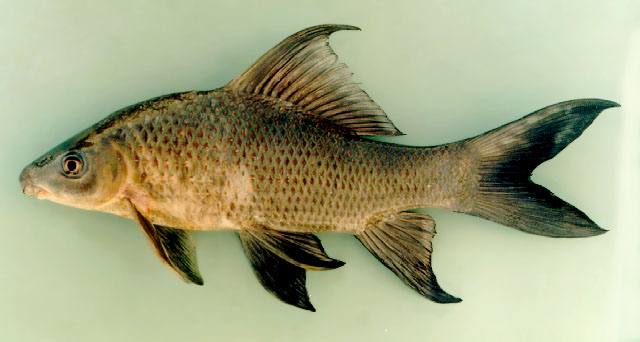| Cyprinidae (Minnows or carps), subfamily: Labeoninae |
| 90 cm TL (male/unsexed); max.weight: 7,000.0 g |
|
benthopelagic; freshwater; pH range: 6.5 - 7.5; dH range: 15, potamodromous |
| Asia: Mekong and Chao Phraya basins, Malay Peninsula, Sumatra, Java and Borneo. |
|
Has black body and fins; a large dorsal fin, with anterior branched dorsal rays longer than head length; 15-18 branched dorsal rays; both lips fringed; juveniles all black; large adults grey with one iridescent spot on each scale (Ref. 27732). |
| Occurs in rivers, streams, canals and inundated floodplains. Sometimes seen in impoundments, but not in great numbers. Like other planktivorous and detritivorous carps, it begins spawning after the first thunderstorms of the coming rainy season. It spawns upstream from shallow sandbars that line long river bends. The eggs settle out in the shallow water and hatch just as water levels begin to rise following the initiation of seasonal rains. The fry immediately move into inundated grasses along the bank and continue to follow the leading edge of the advancing water as floodwaters spread over the land. Adults also migrate out into seasonally flooded areas where they feed on algae, periphyton, phytoplankton and detritus. They return to rivers from October to December (Ref. 12693). In Laos and Thailand, it migrates upstream at the onset of rainy season. In Cambodia, it undertakes upstream migration between October and March and downstream migration from March to August (Ref. 37770). A desirable food fish which is marketed fresh, dried and salted (Ref. 12693). |
|
Least Concern (LC); Date assessed: 03 April 2020 Ref. (130435)
|
| harmless |
|
Found in the Chao Phraya, Mekong River, Maeklong, Salween, Peninsular and Southeast Thailand river systems (Ref. 26336). In the Mekong basin, it migrates upstream from March to August. Known to migrate into tribuatries, small streams and canals and migration commences at the onset of the rainy season or when the water starts rising (Ref. 37770). Has an important spawning ground in Bung Borapet swamp in the Chao Phraya catchment (Ref. 37770). Captured from the wild for the ornamental fish trade (Ref. 6459). Museum: Mekong mainstream between Pak Ing and Jom Paeng, about 4-5 km downstream, CAS 95582 (Ref. 5515); also from Bangkok, Nonthaburi, Phra Nakhon Si Ayutthaya, Nakhon Sawan, Chiang Mai, Kanchanaburi, Kemarat (Ubon Ratchathani), Khon Kaen and Surat Thani (Ref. 37773). Also Ref. 1632, 26580, 27732, 36654, 43281. |
Source and more info: www.fishbase.org. For personal, classroom, and other internal use only. Not for publication.

